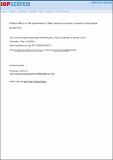Polaron effects on the performance of light-harvesting systems: a quantum heat engine perspective
Author(s)
Zhao, Yang; Cao, Jianshu; Wang, Chen; Xu, Dazhi
DownloadXu-2016-Polaron effects on t.pdf (1.611Mb)
OPEN_ACCESS_POLICY
Open Access Policy
Creative Commons Attribution-Noncommercial-Share Alike
Terms of use
Metadata
Show full item recordAbstract
We explore energy transfer in a generic three-level system, which is coupled to three non-equilibrium baths. Built on the concept of quantum heat engine, our three-level model describes non-equilibrium quantum processes including light-harvesting energy transfer, nano-scale heat transfer, photo-induced isomerization, and photovoltaics in double quantum-dots. In the context of light-harvesting, the excitation energy is first pumped up by sunlight, then is transferred via two excited states which are coupled to a phonon bath, and finally decays to the reaction center. The efficiency of this process is evaluated by steady state analysis via a polaron-transformed master equation; thus the entire range of the system-phonon coupling strength can be covered. We show that the coupling with the phonon bath not only modifies the steady state, resulting in population inversion, but also introduces a finite steady state coherence which optimizes the energy transfer flux and efficiency. In the strong coupling limit, the steady state coherence disappears and the efficiency recovers the heat engine limit given by Scovil and Schultz-Dubois (1959 Phys. Rev. Lett. 2 262).
Date issued
2016-01Department
Massachusetts Institute of Technology. Department of ChemistryJournal
New Journal of Physics
Publisher
IOP Publishing
Citation
Xu, Dazhi et al. “Polaron Effects on the Performance of Light-Harvesting Systems: A Quantum Heat Engine Perspective.” New Journal of Physics 18.2 (2016): 023003. © 2016 IOP Publishing Ltd and Deutsche Physikalische Gesellschaft
Version: Final published version
ISSN
1367-2630